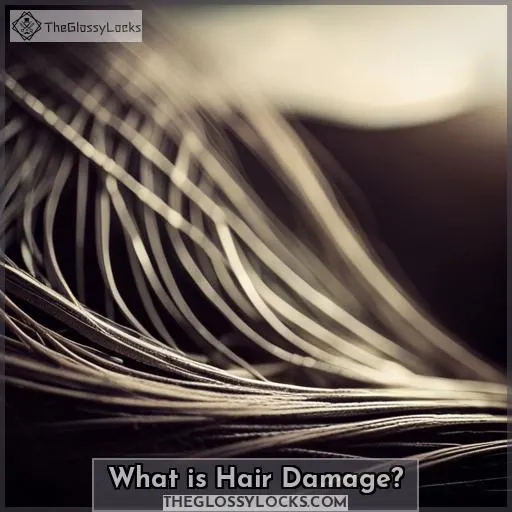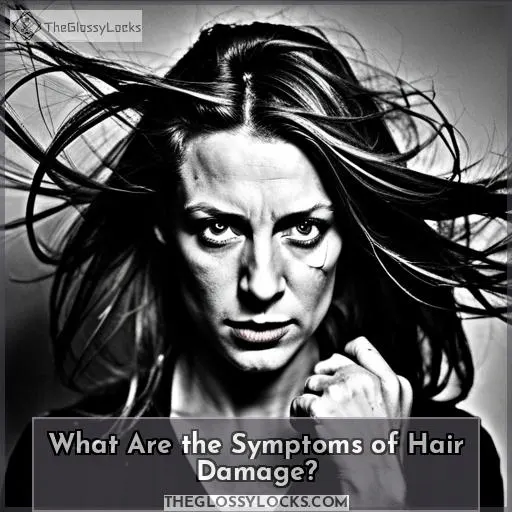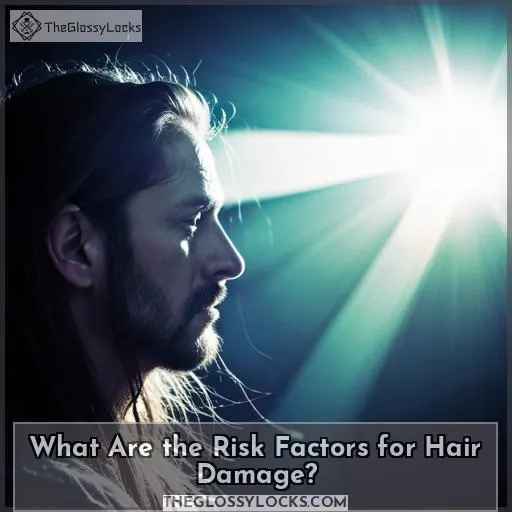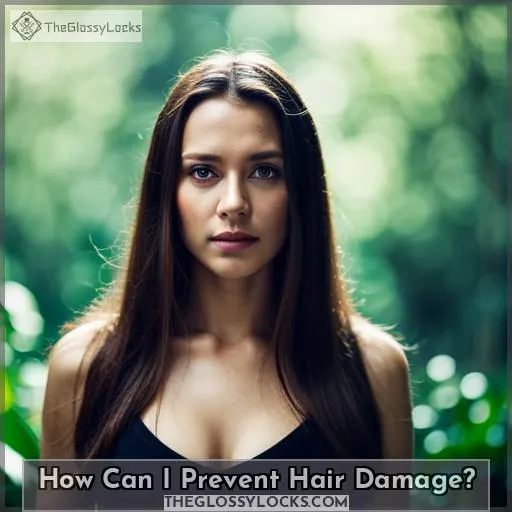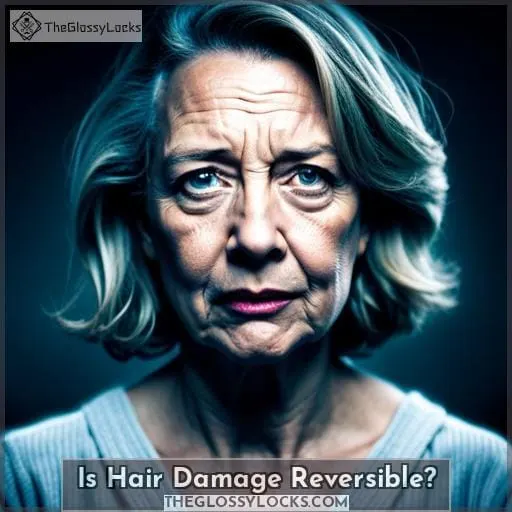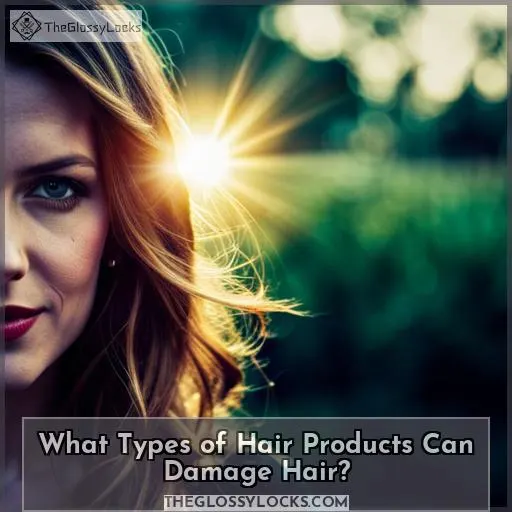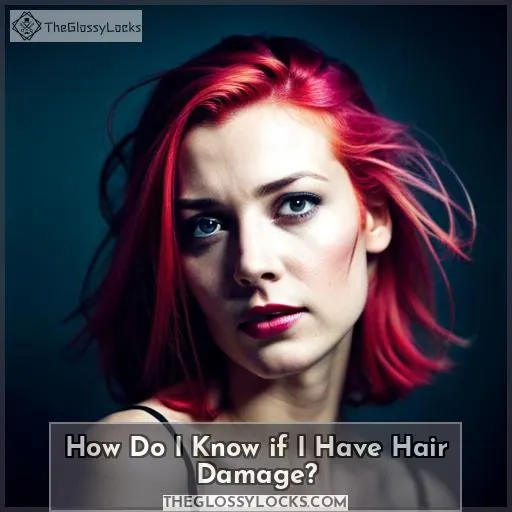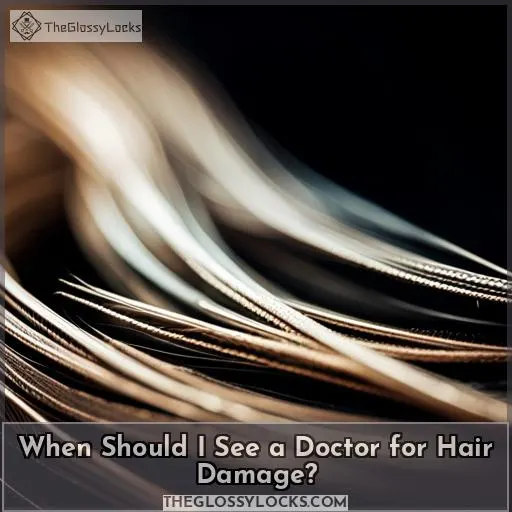This site is supported by our readers. We may earn a commission, at no cost to you, if you purchase through links.
Are you noticing that your hair is getting dry and brittle? Have you been suffering from split ends, breakage, or excessive shedding? If so, these could be signs of hair damage. Hair damage can occur due to a variety of factors such as over-brushing, heat exposure without proper hydration and protection from the elements.
In this article, we take an in-depth look at what causes hair damage and how it can be prevented through changes to your haircare routine along with dietary adjustments.
Table Of Contents
- Key Takeaways
- What is Hair Damage?
- What Are the Symptoms of Hair Damage?
- What Causes Hair Damage?
- What Are the Risk Factors for Hair Damage?
- How Can I Prevent Hair Damage?
- Is Hair Damage Reversible?
- What Types of Hair Products Can Damage Hair?
- How Do I Know if I Have Hair Damage?
- What Are the Treatment Options for Hair Damage?
- When Should I See a Doctor for Hair Damage?
- Frequently Asked Questions (FAQs)
- Conclusion
Key Takeaways
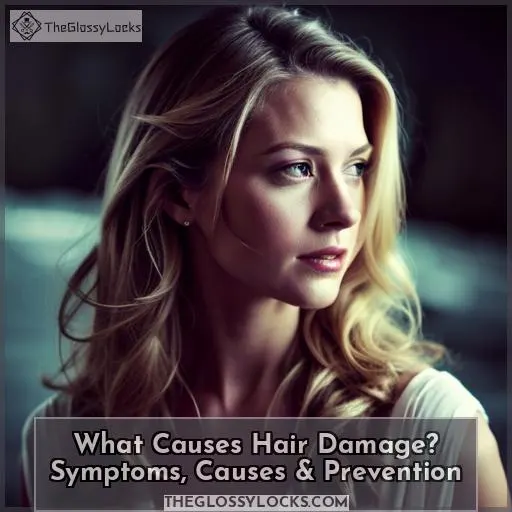
- Over-brushing, heat exposure, tight hairstyles, and eating disorders are common causes of hair damage.
- Hair damage can be prevented by protecting the hair from extreme heat and using cool-down treatments.
- Regular trims and scalp moisturization are important for maintaining healthy hair.
- Harsh treatments, sunlight exposure, and lack of regular haircuts can worsen hair damage.
What is Hair Damage?
You may be familiar with the effects of hair loss, but have you ever heard of hair damage? Hair damage can range from split ends to breakage and is often caused by a combination of environmental factors such as heat styling or chemical treatments, as well as stress.
The best way to protect your tresses is by avoiding extreme heat and following up any hot styling tools with a cool-down treatment.
Creating an overall healthy hair care routine that includes protecting your locks from the elements will go a long way in preserving its condition over time.
What Are the Symptoms of Hair Damage?
Experiencing dryness, breakage, split ends, and brittle strands can be telltale signs that your hair is damaged. Hair damage is often caused by a combination of environmental factors, such as heat styling or chemical treatments, along with stress.
To prevent further damage to tresses, it’s important to avoid harsh treatments, protect from sunlight exposure, and get regular haircuts. Cooling caps are also available for those undergoing chemotherapy who wish to reduce their risk of hair loss due to the treatment itself.
Dietary changes may help improve certain medical conditions like alopecia, while some other forms of baldness, such as androgenic alopecia, cannot be prevented but rather managed using medications or specialized medical treatments in extreme cases where needed.
Some key steps when following any kind of hair care routine include avoiding tight hairstyles that pull on strands too much with elastic ties or clips.
What Causes Hair Damage?
You may have heard of certain habits and lifestyle factors that can cause damage to your hair, such as over-brushing, using heat for styling, or lack of moisture. Other causes include towel-drying too harshly, not having regular haircuts, poor diet choices, and tight hairstyles that pull on strands.
Stress levels also play a role in hair health, along with medical conditions like thyroid disorders or eating disorders.
Over-brushing
Over-brushing your tresses can be a major disaster, causing catastrophic breakage and split ends. Avoid overbrushing, use heat protection, moisturize hair regularly, and get regular trims. Loosen hairstyles when wet or in hot weather to reduce shock that causes unusual amounts of shedding.
Heat and Lack of Moisture
Excessive heat styling and lack of moisture can wreak havoc on your tresses, leading to breakage and split ends.
- Heat Protection
- Moisturizing Tips
- Hair Masking & Hydrating Treatments
Regular trims help prevent dryness and brittle strands by removing damage at the hair shafts. Prevent further harm; use hydrating treatments for soft, healthy locks!
Towel Drying
Towel drying isn’t ideal; moisture is lost and breakage is caused. Gently brush your hair and avoid heat. Also, wear protective styles. Moisturizers help maintain haircuts, and cooling caps reduce hair loss during chemical treatments.
Not Having Regular Haircuts
Not having regular haircuts can create split ends, breakage, and weaken the strands of your hair! Protecting your hair with regular trims is essential to maintaining its health. Avoid using heat styling tools and make sure to have a balanced diet free from nutritional deficiencies for healthy locks.
Stress management, along with a balanced diet, will keep your mane looking great! Get trims regularly to fully protect against extreme stress or lack of maintenance that may damage hair over time.
Diet
Maintaining a balanced diet with sufficient nutrients is key to keeping your hair healthy and strong! Eating habits, protein intake, vitamin deficiencies, hydration habits, and selenium levels all affect hair health.
Nutritional deficiencies can lead to medical conditions impacting the family history of healthy hair growth.
Tight Hairstyles
Wearing tight hairstyles, such as braids or ponytails, can exert strain on hair follicles and lead to breakage and thinning in up to one-third of women. To minimize damage, it is recommended to opt for protective styling, utilize oils and heat protection products, apply moisturizing masks, use wide-toothed combs and rubber bands instead of elastics.
Additionally, it is crucial to identify underlying causes, such as heart problems, in order to promote healthy hair growth.
Stress
Experiencing high levels of stress can put your hair health at risk, leading to breakage and thinning. Reducing tension through a healthy diet, regular haircuts with minimal heat styling, and moisturizing may help.
Thyroid disorders or nutrient deficiencies also contribute to poor hair strand growth. The American Academy of Dermatology recommends seeking medical advice for further assistance.
Thyroid Disorders
Thyroid disorders, like a storm cloud of hair hurt, can lead to thinning and breakage. Testing and nutrition are key for restoring growth. Stress management, along with managing hormonal changes, may prevent future damage.
Eating Disorders
Eating disorders can cause hair damage due to nutritional deficiency and hormonal imbalance. Genetics, nutrition, stress, and diet all play a role in hair health. Hereditary factors may contribute to sudden loosening of hair, while severe nutrient deficiencies lead to alopecia areata or complete baldness.
The psychological impact of this condition should not be underestimated; seek help following diagnosis for the best results.
What Are the Risk Factors for Hair Damage?
Understanding the factors that can put your hair at risk is like taking a crash course in healthy tresses – from styling habits to medical conditions. Heat damage, excessive brushing, tight hairstyles, and lack of moisture are just some of the common causes.
On top of this, certain health issues such as thyroid disorders or eating disorders may also take their toll on your mane.
To protect against hair loss and damage, use heat sparingly. Be gentle with towels and trim regularly. Keep up with good nutrition and stress management techniques. Choose wisely when it comes to products for care and styling purposes.
Finally, stay informed about current health topics – what’s causing someone else’s excessive hair loss could help you identify potential sources of harm for yourself!
How Can I Prevent Hair Damage?
It’s important to take proactive steps in order to prevent hair damage. Start by assessing the products you use on your hair; choose those that are designed specifically for the type of hair you have. Using a conditioner and a deep conditioning treatment once or twice per week is also beneficial in keeping locks healthy and strong.
Reducing stress levels is another important factor in preventing hair damage. Stress management techniques such as yoga or meditation may be helpful in combating excessive shedding due to an overactive mind-body response system.
Lastly, consider adjusting your diet. Certain vitamins and minerals found naturally within food are essential for healthy tresses.
Change Haircare Routine
To protect your tresses, consider changing up your hair care routine. Daily care and hair oils can help keep damage at bay, while heat protection products and protective styling are key for reducing the risk of harm.
Natural remedies like aloe vera or nut-rich diets offer hair-boosting selenium too! It’s important to stay informed about health tips, treatment options for symptoms of hair loss, as well as common causes of breakage – all these steps will give you the best chance to avoid further damage.
Use a Conditioner
Using a deep conditioner after shampooing can help nourish your hair, reducing breakage due to environmental or lifestyle factors. Conditioner usage will protect and improve the health of your hair while also managing stress levels related to haircuts.
Learn more about health information, treatments for common types of hair loss, along with an increasingly popular pattern among older women.
Reduce Stress
Reducing stress can help protect your hair from damage and keep it looking its best! Stress management techniques like yoga, meditation, deep breathing exercises, massage therapy, and other relaxation methods are beneficial in reducing the effects of stress on the body.
Such activities could prevent patchy bald spots or further hair loss as a side effect of certain drugs or an impaired immune system due to current issues people face.
Dietary Changes
Tweaking your diet can help keep your strands healthy and strong – adding more iron-rich foods like spinach, broccoli, and eggs will give you the boost of nourishment needed. Achieving dietary balance is key to avoiding nutrient deficiencies that could lead to hair loss or damage.
Hair supplements, masks, and stress management are other ways to maintain healthy locks! The most common cause of hair loss? Dietary changes! Revamp yours today for luscious locks tomorrow.
Is Hair Damage Reversible?
Discovering the root cause of your hair loss is key to determining if it’s reversible or not. To prevent further damage, avoid heat styling tools and use moisturizers designed for your specific hair type.
Additionally, take care of your scalp by using protective hairstyles to help reduce breakage and encourage healthy growth. Eating a balanced diet with plenty of fruits and vegetables will also provide essential vitamins and minerals that are beneficial to maintaining strong locks.
If you’re experiencing more severe health issues such as radiation therapy or chemotherapy, early treatment may be necessary to limit baldness across the entire body. Mayo Clinic recommends patients discuss potential risks associated with treatments before undergoing any medical procedures that could lead to permanent changes in appearance, such as hair loss.
What Types of Hair Products Can Damage Hair?
Using certain hair products can wreak havoc on your locks, leaving them dry, brittle, and lifeless. Heat styling tools are one of the most common causes of damage to the hair shaft due to their high temperatures that strip away moisture from strands.
Avoiding chemical treatments such as bleach or highlights may also help prevent breakage caused by harsh ingredients in these products. Keeping your locks moisturized with conditioners designed for specific hair types will keep it healthy and strong over time.
Using natural oils or creams is recommended instead of synthetic forms since they don’t contain any harmful chemicals that could damage the scalp and roots over time.
Opting out from email communications related to promotions involving potentially damaging hair care items is another way you can protect yourself against further damage – so be sure you’re not missing out on those messages!
With all these tips combined, you’ll be able to avoid baldness associated with unhealthy habits while maintaining strong locks throughout life’s journey!
How Do I Know if I Have Hair Damage?
It’s important to know how to tell if you have hair damage so that you can take steps to protect your locks. Signs of hair damage include split ends, dryness or brittleness, thinning strands, and excessive shedding.
Other symptoms may also be present such as breakage when combing or styling the hair.
To help protect your tresses from further harm, utilize moisturizing products designed for your specific type of locks. Manage stress levels with regular exercise and relaxation techniques. Use quality products specifically meant for protecting the scalp and roots.
Get regular haircuts every 6-8 weeks in order to keep any existing damage at bay.
If left untreated, damaged tresses can lead to increased rates of shedding which will eventually result in baldness over time! Taking proactive measures now by following these simple tips is key for ensuring healthy-looking locks long into the future!
What Are the Treatment Options for Hair Damage?
Exploring the available treatment options for hair damage can help you keep your locks looking and feeling healthy. Using quality products, such as leave-in conditioners, and avoiding heat styling tools are key to keeping your tresses in good shape.
Eating a balanced diet full of essential nutrients and reducing stress are also important factors. Additionally, regular trims every 6-8 weeks will ensure that any existing damage is kept at bay. It’s also important to be gentle when brushing or combing through wet strands to prevent breakage.
When Should I See a Doctor for Hair Damage?
If you’re distressed by persistent hair loss or notice sudden or patchy hair loss, it’s important to see a doctor.
- Regular haircuts every 6-8 weeks.
- Avoid heat styling tools and use quality leave-in conditioner products.
- Incorporate essential nutrients into your diet and reduce stress levels.
Additionally, be gentle when towel drying as this can help reduce breakage of strands, which can lead to further damage over time.
Frequently Asked Questions (FAQs)
Can I reverse hair damage?
You can reverse some types of hair damage. To do this, seek professional advice and treatments that target the cause of your hair loss or damage. Be gentle with your hair to prevent further breakage, use products designed for damaged strands, and eat a balanced diet rich in vitamins A and E to support healthy growth.
What types of hair products can damage my hair?
From excessive heat styling to sulfates and alcohols, many hair products can damage your locks. Choose wisely: opt for gentler formulas that nourish while you style. Consider cream-based conditioners or a protein mask to help keep strands healthy, strong, and beautiful.
How do I know if I have hair damage?
Look for signs of split ends, dryness, breakage, or brittleness. Take a closer look at the shafts – if they are rough to the touch and have an uneven appearance, then your hair may be damaged. If it lacks luster and shine with little to no elasticity, that is also indicative of damage.
What are the treatment options for hair damage?
If your hair is damaged, there are several treatment options available. Consider using nourishing shampoos and conditioners, deep conditioning treatments, avoiding heat styling tools or chemical processes like coloring.
Look into natural remedies such as coconut oil and apple cider vinegar to help restore the health of your strands.
When should I see a doctor for hair damage?
If hair damage persists or appears suddenly, it’s important to visit a doctor. They can assess the cause and discuss treatment options that could help prevent further harm. Consider family history, age, medical conditions, and lifestyle habits for answers.
Conclusion
By taking preventive measures like changing your hair care routine, using a conditioner, reducing stress, and making dietary changes, you can reduce your risk of hair damage.
Your hair is an important part of your identity, and it’s worth taking the time to treat it with the care it deserves. However, if you’ve already experienced hair damage, there are treatments available that can help.
Seeing a doctor or a trichologist can help you determine the best course of action for your hair. Don’t let hair damage get you down. With the right knowledge and care, you can keep your hair healthy and beautiful.

